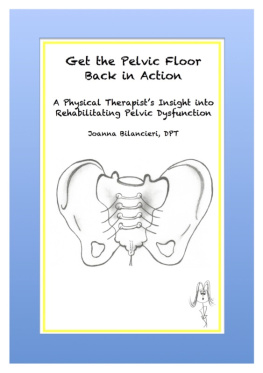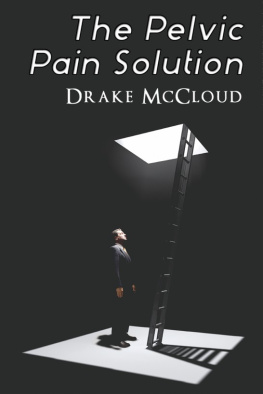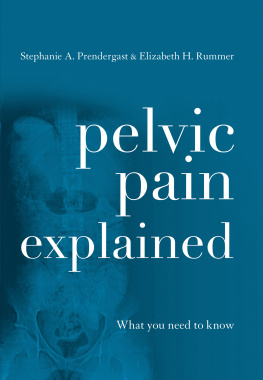Heal Pelvic Pain
Heal Pelvic Pain
A Proven Stretching, Strengthening,
and Nutrition Program for Relieving
Pain, Incontinence, IBS, and Other
Symptoms Without Surgery
AMY STEIN, M.P.T.
FOREWORD BY ANDREW GOLDSTEIN, M.D.


Copyright 2009 by Amy Stein. All rights reserved. Manufactured in the United States of America. Except as permitted under the United States Copyright Act of 1976, no part of this publication may be reproduced or distributed in any form or by any means, or stored in a database or retrieval system, without the prior written permission of the publisher.
007154657X
The material in this eBook also appears in the print version of this title: 0-07-154656-1.
All trademarks are trademarks of their respective owners. Rather than put a trademark symbol after every occurrence of a trademarked name, we use names in an editorial fashion only, and to the benefit of the trademark owner, with no intention of infringement of the trademark. Where such designations appear in this book, they have been printed with initial caps.
McGraw-Hill eBooks are available at special quantity discounts to use as premiums and sales promotions, or for use in corporate training programs. For more information, please contact George Hoare, Special Sales, at george_hoare@mcgraw-hill.com or (212)904-4069.
TERMS OF USE
This is a copyrighted work and The McGraw-Hill Companies, Inc. ("McGraw-Hill") and its licensors reserve all rights in and to the work. Use of this work is subject to these terms. Except as permitted under the Copyright Act of 1976 and the right to store and retrieve one copy of the work, you may not decompile, disassemble, reverse engineer, reproduce, modify, create derivative works based upon, transmit, distribute, disseminate, sell, publish or sublicense the work or any part of it without McGraw-Hill's prior consent. You may use the work for your own noncommercial and personal use; any other use of the work is strictly prohibited. Your right to use the work may be terminated if you fail to comply with these terms.
THE WORK IS PROVIDED "AS IS." McGRAW-HILL AND ITS LICENSORS MAKE NO GUARANTEES OR WARRANTIES AS TO THE ACCURACY, ADEQUACY OR COMPLETENESS OF OR RESULTS TO BE OBTAINED FROM USING THE WORK, INCLUDING ANY INFORMATION THAT CAN BE ACCESSED THROUGH THE WORK VIA HYPERLINK OR OTHERWISE, AND EXPRESSLY DISCLAIM ANY WARRANTY, EXPRESS OR IMPLIED, INCLUDING BUT NOT LIMITED TO IMPLIED WARRANTIES OF MERCHANTABILITY OR FITNESS FOR A PARTICULAR PURPOSE. McGraw-Hill and its licensors do not warrant or guarantee that the functions contained in the work will meet your requirements or that its operation will be uninterrupted or error free. Neither McGraw-Hill nor its licensors shall be liable to you or anyone else for any inaccuracy, error or omission, regardless of cause, in the work or for any damages resulting therefrom. McGraw-Hill has no responsibility for the content of any information accessed through the work. Under no circumstances shall McGraw-Hill and/or its licensors be liable for any indirect, incidental, special, punitive, consequential or similar damages that result from the use of or inability to use the work, even if any of them has been advised of the possibility of such damages. This limitation of liability shall apply to any claim or cause whatsoever whether such claim or cause arises in contract, tort or otherwise.
DOI: 10.1036/0071546561

Want to learn more?
We hope you enjoy this McGraw-Hill eBook! If you'd like more information about this book, its author, or related books and websites, please .
CONTENTS
CHAPTER 1
AT THE BODY'S CORE |
CHAPTER 2
WHEN THE PELVIC FLOOR IS NOT HEALTHY |
CHAPTER 3
END THE PAIN |
CHAPTER 4
STRENGTHEN THE MUSCLES |
CHAPTER 5
GIVE YOURSELF A MASSAGE |
CHAPTER 6
EAT RIGHT FOR A HEALTHY PELVIC FLOOR |
CHAPTER 7
RELAX AND TAKE CARE OF YOURSELF |
CHAPTER 8
BETTER SEX FOR MORE YEARS |
CHAPTER 9
PREGNANCY, LABOR, AND POSTDELIVERY |
CHAPTER 10
PELVIC FLOOR DISORDER IN CHILDREN |
CHAPTER 11
FOR MEN ONLY |
CHAPTER 12
THE NATURAL WAY TO HEAL PELVIC PAIN |
APPENDIX A
DISORDERS OF THE PELVIC FLOOR: SIGNS AND SYMPTOMS, CONSEQUENCES, AND CAUSES |
APPENDIX B
RESOURCES |
APPENDIX C
WHAT PATIENTS SAY |
FOREWORD
.
When I was in medical school back in the 1990s, physical therapy (PT) was regarded as something of an afterthought. Since physical therapists rarely published studies in journals read by physicians, the PT practice lacked scientific cloutat least as far as doctors were concerned. When physical therapy was considered, it was seen as useful mostly for damaged muscles and joints after injury or surgery. In other words, after doctors had done the real work, you might prescribe physical therapy for the mop-up.
Despite completing nearly 20,000 hours of internship and residency in obstetrics and gynecology, I heard only one hour-long lecture on vulvar pain and sexual dysfunction. I was taught that pain during sex was the result of "vaginismus," an involuntary contraction of the vaginal muscles during attempted penetration. I was further taught that vaginismus was a psychological issue resulting from trauma or abuse, and that it was to be treated through psychotherapy and sex therapy. Physical therapy was never mentioned. Other types of vulvar pain were thought to be caused by nerve injury and were treatedas much as possiblewith drugs. Again, physical therapy was never discussed as a treatment for women suffering this pain, nor was I ever taught anything about pelvic floor disorders in men!
After completing my residency, I joined the faculty of Johns Hopkins and became the director for the Center for Vulvovaginal Disorders. A great many of the patients with whom I dealt had suffered pain for a decade or more. Prescription drugs controlled the pain, but they did not cure it and often produced significant side effectsincluding heart palpitations, extreme lethargy, weight gain, dry mouth, and constipation. If it was a steep price for these women to pay for the relief of their pain, few people in the medical profession questioned the situation or challenged the assumptions on which this standard therapy was basednamely, that the chronic pain was solely due to nerve injuryneuropathy, in medical lingo.
The only problem with this "wisdom" was that it wasn't true. It took some forward-looking physical therapists like Amy Stein, the very folks we doctors had typically paid little attention to, to enlighten us on what was really at issue.
It's not too far-fetched to say that Amy and her colleagues had to beat down the doors of the medical establishmentfiguratively, anywayto be heard. They made their case with compelling logic, arguing that the cause of much of the pain we were treating with medication was not, in fact, neuropathic, but instead myofascialthat is, in the muscles and tissue. The pain, they explained, was a result of the muscles having tightened and shortened. The tightening had decreased the blood flow and therefore the supply of oxygen to the affected muscles; as a result, lactic acid built up, irritating the nerves that pass through the muscles. As the brain perceives pain as being located in the end organ reached by the affected nerve, the person felt vulvar pain. In addition, the irritation of the nerve typically gives rise to an inflammation that produces redness and swelling, and the redness and swelling, like the pain, show up in the "endpoint" organ reached by the irritated nervenamely, the vulva.
Next page










